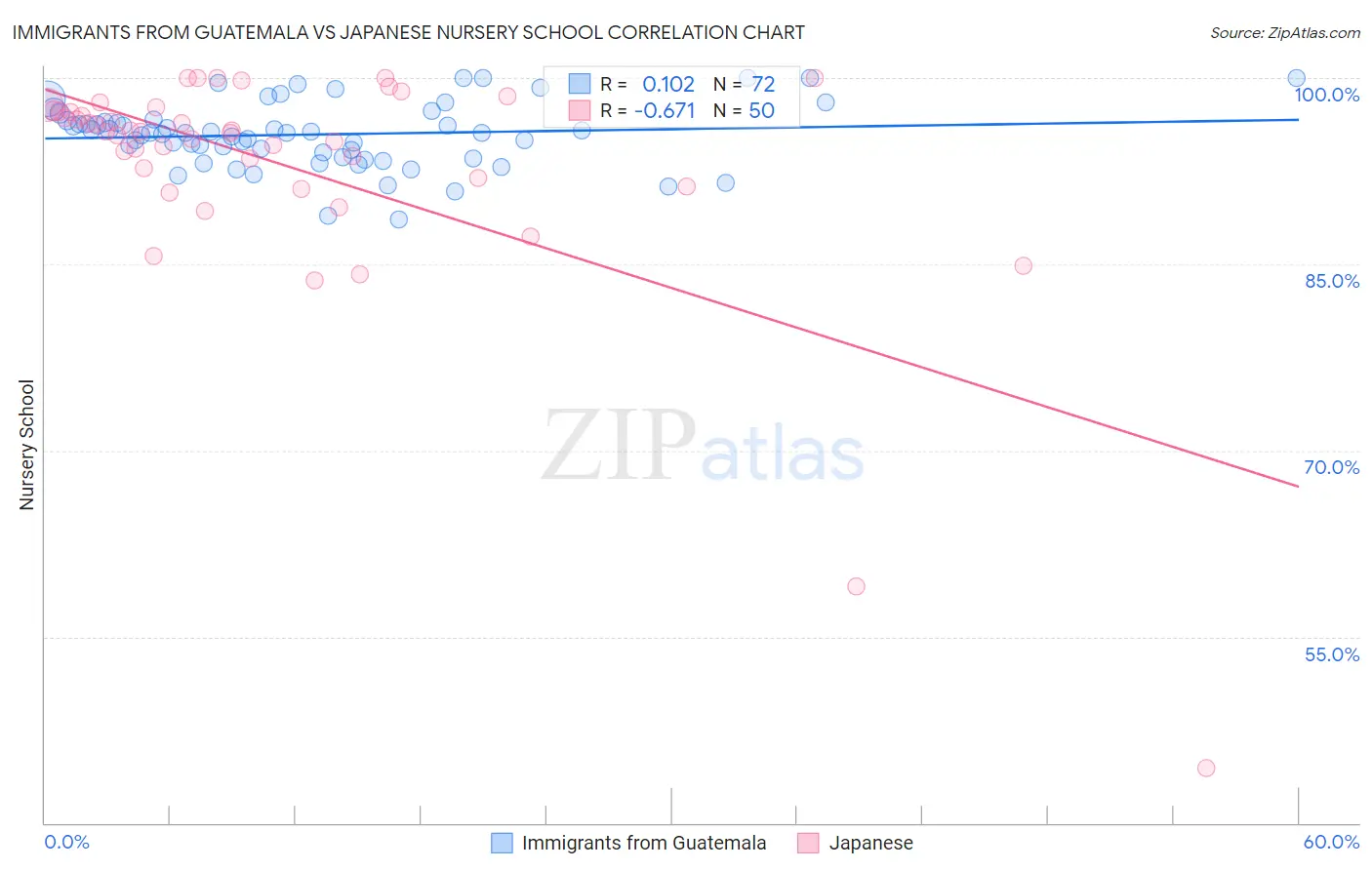Immigrants from Guatemala vs Japanese Nursery School
COMPARE
Immigrants from Guatemala
Japanese
Nursery School
Nursery School Comparison
Immigrants from Guatemala
Japanese
96.4%
NURSERY SCHOOL
0.0/ 100
METRIC RATING
339th/ 347
METRIC RANK
96.7%
NURSERY SCHOOL
0.0/ 100
METRIC RATING
330th/ 347
METRIC RANK
Immigrants from Guatemala vs Japanese Nursery School Correlation Chart
The statistical analysis conducted on geographies consisting of 377,282,938 people shows a poor positive correlation between the proportion of Immigrants from Guatemala and percentage of population with at least nursery school education in the United States with a correlation coefficient (R) of 0.102 and weighted average of 96.4%. Similarly, the statistical analysis conducted on geographies consisting of 249,183,224 people shows a significant negative correlation between the proportion of Japanese and percentage of population with at least nursery school education in the United States with a correlation coefficient (R) of -0.671 and weighted average of 96.7%, a difference of 0.24%.

Nursery School Correlation Summary
| Measurement | Immigrants from Guatemala | Japanese |
| Minimum | 88.6% | 44.4% |
| Maximum | 100.0% | 100.0% |
| Range | 11.4% | 55.6% |
| Mean | 95.4% | 93.0% |
| Median | 95.6% | 95.6% |
| Interquartile 25% (IQ1) | 93.8% | 92.0% |
| Interquartile 75% (IQ3) | 96.7% | 97.4% |
| Interquartile Range (IQR) | 2.9% | 5.4% |
| Standard Deviation (Sample) | 2.6% | 9.6% |
| Standard Deviation (Population) | 2.6% | 9.5% |
Demographics Similar to Immigrants from Guatemala and Japanese by Nursery School
In terms of nursery school, the demographic groups most similar to Immigrants from Guatemala are Immigrants from Central America (96.4%, a difference of 0.030%), Immigrants from Cabo Verde (96.4%, a difference of 0.060%), Immigrants from Mexico (96.4%, a difference of 0.060%), Immigrants from Cambodia (96.5%, a difference of 0.080%), and Immigrants from Fiji (96.5%, a difference of 0.080%). Similarly, the demographic groups most similar to Japanese are Immigrants from Vietnam (96.7%, a difference of 0.010%), Immigrants from Armenia (96.7%, a difference of 0.020%), Yakama (96.6%, a difference of 0.040%), Immigrants from Latin America (96.7%, a difference of 0.060%), and Central American (96.6%, a difference of 0.060%).
| Demographics | Rating | Rank | Nursery School |
| Vietnamese | 0.0 /100 | #324 | Tragic 96.8% |
| Dominicans | 0.0 /100 | #325 | Tragic 96.8% |
| Indonesians | 0.0 /100 | #326 | Tragic 96.8% |
| Mexicans | 0.0 /100 | #327 | Tragic 96.8% |
| Immigrants | Latin America | 0.0 /100 | #328 | Tragic 96.7% |
| Immigrants | Vietnam | 0.0 /100 | #329 | Tragic 96.7% |
| Japanese | 0.0 /100 | #330 | Tragic 96.7% |
| Immigrants | Armenia | 0.0 /100 | #331 | Tragic 96.7% |
| Yakama | 0.0 /100 | #332 | Tragic 96.6% |
| Central Americans | 0.0 /100 | #333 | Tragic 96.6% |
| Immigrants | Dominican Republic | 0.0 /100 | #334 | Tragic 96.6% |
| Bangladeshis | 0.0 /100 | #335 | Tragic 96.6% |
| Guatemalans | 0.0 /100 | #336 | Tragic 96.6% |
| Immigrants | Cambodia | 0.0 /100 | #337 | Tragic 96.5% |
| Immigrants | Fiji | 0.0 /100 | #338 | Tragic 96.5% |
| Immigrants | Guatemala | 0.0 /100 | #339 | Tragic 96.4% |
| Immigrants | Central America | 0.0 /100 | #340 | Tragic 96.4% |
| Immigrants | Cabo Verde | 0.0 /100 | #341 | Tragic 96.4% |
| Immigrants | Mexico | 0.0 /100 | #342 | Tragic 96.4% |
| Salvadorans | 0.0 /100 | #343 | Tragic 96.4% |
| Immigrants | El Salvador | 0.0 /100 | #344 | Tragic 96.2% |